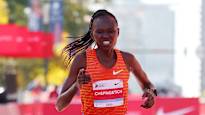When the athletics season drew to a close over the weekend, the world record had already been set during the Olympic season in six sports included in the competition program.
The last to join the group was the 2019 world champion on Sunday in Chicago Ruth Chepngetichwho on the fast route of Chicago cut a marathon from ME by as much as one minute and 57 seconds. The Kenyan was the first woman to run 42.195 kilometers in under two hours, 10 minutes, four seconds.
The result meant that if the previous ME athlete Tigst Assefa had been at his record pace in Chicago, he would have had about 634 meters to go to the finish line when Chepngetich already raised his hands.
“I thought it was incredible”
– The ME improvement of almost two minutes is a sensation. I thought such a result was unbelievable, but you have to believe it when he ran it. I will not comment further, well-known Italian manager Gianni Demadonna said to Urheilu on Monday.
The clients of his Demadonna Athletics Promotion company include e.g. Assefa, who won Olympic silver in Paris and therefore missed Chicago due to too short a recovery time.
Chepngetich’s management company, on the other hand, belongs to another Italian ie Federico Rosan run by Rosa and Associati. When you add a Belgian to this Marc Corstjens and Dutch If Hermensthere is a quartet of managers whose stables include the majority of the East African marathon cream of the planet.
Finnish history of athletics
The proportions of Chepngetich’s performance are staggering. The woman ran each 100 meters in an average of 18.48 seconds. The man who ran the first marathon faster was an Australian Derek Clayton2.09.36 in December 1967. After Sunday, the Finnish record in the men’s Olympic sport is weaker than the women’s world record in a comparable sport, for the first time in the history of athletics.
Federico Rosa has had problems in the past, e.g. Kenyan authorities with related to doping. Gianni Demadonna tells Urheilu that he does not criticize his colleague because the customer problems in question are not completely for him too guests.
– Of course, you should ask the AIU (Athletics Integrity Unit, athletics’ anti-doping supervisor), for example, how and how intensively he (Chepngetich) has been tested, especially outside of competitions. I know from my own experience that it is completely impossible for a manager living abroad to know exactly what his athletes are doing while in East Africa. The level of education and knowledge of the athletes also often leaves much to be desired.
“Blah, blah, blah”
Demadonna isn’t exactly fooling around when she thinks that out-of-competition doping testing in the East African region is not reliable in her eyes. He emphasizes that he is not talking about a recent ME woman per se, but evaluates the phenomenon on a general level.
Chepngetich belongs to AIU to the testing pool, i.e. according to the rules, he must, for example, be able to indicate the place and hour slot of each day when doping testers are sure to be available.
– Kenya and out-of-competition testing. Blah, blah, blah, Demadonna acknowledges.
For example, in the case of Kenya, the Manager’s cynicism is supported AIU statistics: no fewer than 111 Kenyan track and field athletes are currently suspended. Top marathons World Marathon Majors tour that is, the promoters of Chicago, New York, Boston, Berlin, London and Tokyo have prepared for doping problems with a special contract model.
Bonus money, such as Chepngetich’s $150,000 from Chicago, is paid in installments of up to three years. A possible doping violation leads to suspension of payment and even recovery. Two-thirds of the reward came from the win, one-third from the remaining time.
In recent years, the top times in endurance running, both on the track and on the street, have largely and partly been attributed to new shoe innovations.
– A top woman can benefit from them in a marathon for about two minutes, but they are no longer a new invention. The Nike model used by Chepngetich in Chicago has been running for quite some time. Likewise with the Asics model, which won the men’s victory.
by John Korir 2.02.43 is the 6th hardest time of all time.
When Urheilu interviewed Demadonna in the aftermath of the 2023 Chicago Marathon, the expected value of this was that the men’s ghost limit, i.e. two hours, falls clearly faster than the women’s 2.10. Young Kelvin Kiptum was only 35 seconds short of the men’s phantom line in Chicago, or a couple of hundred meters, but he died last February in a traffic accident.
Demadonna predicted a year ago that Assefan ME would last much longer. At that time, he guessed Holland to be the first underdog of 2.10 Sifan Hassaniabut this one bet on the Olympic Games in Paris, won the marathon in France and didn’t come to Chicago.
Although the women’s marathon has grown drastically as an athletics business and top sport, Demadonna reminds us of the youth of the sport’s history. It can still be seen directly in the statistics. Chepngetich’s ME time is 5.02 minutes away from fifth in the all-time record, ie Amane Beriso.
In the men’s all-time statistics, he ranks 157th with a time exactly five minutes slower than ME. If the difference is stretched to 10 minutes, 81 women can fit in, 1807 men.
– Women’s marathon running is already a very tough elite sport, but the development potential is still huge.
